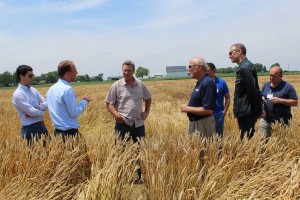WOOSTER, Ohio — A delegation of foreign wheat purchasers and traders visited the research being done at Ohio State University’s Ohio Agricultural Research and Development Center, June 26.
The trip was part of a weeklong tour of select U.S. wheat destinations, organized through the U.S. Wheat Associates — the export market development organization for the nation’s wheat industry.
The nations included Spain, Italy, the Netherlands and Malta. The tour began with an overview of the Soft Wheat Quality Lab at the OARDC, and concluded with a visit to the university’s research plots.
Genomic selection
Clay Sneller, wheat researcher and breeder, said one of the biggest trends in recent years has been genomic selection. This is different from genetic modification, and allows researchers to analyze wheat genes in about a year’s time, compared to what used to take seven years, Sneller said.
The varieties that Sneller and his students develop are released into the public marketplace, with some of them going to private business, depending on the agreements with each research project.
Statistically, he said about 70 percent of U.S. wheat acres are planted to public wheat varieties, which means they’ve been researched by universities and made publicly available.
In the eastern U.S., however, he said only about 30 percent of seed comes from public varieties, with the rest coming from private companies. One reason is that eastern farmers usually grow fewer acres of wheat, and are more willing to buy new seed each year, as opposed to storing public seeds.
Excellent traits
As a researcher, his goal is to develop varieties that are excellent for every trait — but in reality, that almost never happens, he explained.
“So, we have to compromise on some traits,” he said. “We can never compromise on yield because if it doesn’t have high yield, the farmers won’t buy it.”
Some varieties are more resistant to stem damage, or lodging, in which the stems bend toward the ground. But even those that are partially bent can usually still be harvested, Sneller said.
He said there’s a strong need for additional wheat research, but added that wheat acres in the eastern U.S. are dropping, and research here is becoming more difficult to fund.
Like in the U.S., the condition of the wheat crop in European countries has been weather-dependent. Ramon Lopez, a procurement manager from Navarra, Spain, said the quantity has been good where the rains fell, but not so good in places where there were fewer rains.
The country usually produces about 20 million tons of all grain, and must import about 10 million tons.
Reassure buyers
Rutger Koekoek, marketing specialist with U.S. Wheat Associates, from Rotterdam, the Netherlands, said the goal of the group was to “learn more about the varieties and to reassure the buyers … that (breeding) quality remains a very high priority.”

He said European buyers produce some of the best flour in the world, and to do so, they need the best wheat.
“European buyers are very critical buyers when it gets to quality,” he said.
They are especially critical of genetic modification — which is not currently available in wheat — but is being practiced in corn and soybean varieties.
“Politically speaking, it’s (GMOs) still a sensitive subject,” he said.
In addition to the research, Koekoek said one of the things that impressed him most was the U.S. transportation system.
“Efficient transportation allows the U.S. wheat to be priced quite competitively, despite the fact that it is grown in the central part of the United States, and very far away from the coast,” he said.
The group’s tour included a visit to the Duluth Seaway Port Authority, in Minnesota, which is billed as mid-America’s “gateway to global trade,” and connects mid-American grains to the Great Lakes region, and the rest of the world.
The Ohio portion of the tour was sponsored in part by the Ohio Small Grains Marketing Program, and led by Brad Moffitt, director of market development and membership.











